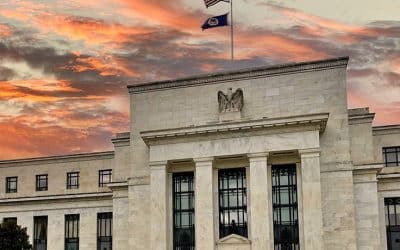The end of the rate hike cycle is getting closer and closer

Redacción Mapfre
After a generally poor October for returns on the vast majority of financial assets, some investors are breathing a sigh of relief thanks to the strong upward movement in the first days of November. It’s true that the market seems much calmer now, especially after the decision of the U.S. Federal Reserve (Fed) to keep interest rates unchanged for the second consecutive time. However, like the woman in the photo that accompanies this monthly market update, these underlying currents aren't convincing us that it's the best moment to take the plunge.
From a macroeconomic perspective, there are no reasons to justify the abrupt movements of the last ten days. However, it’s equally true that the macroeconomic context didn’t change enough in October to justify losses of around 3% for stocks and over 1% for the vast majority of fixed-income indices.
The market continues to swing like a pendulum, and its gravitational shifts are influenced by the stance the central banks are expected to take on the macroeconomic data being released. There’s a hope that “the worse it gets, the better for the market,” because the cycle of interest rate hikes would be closer to ending. Investing under this premise garnered excellent results during the last decade when inflation wasn’t a problem. Nevertheless, as we’ve been noting for the past year, we’re entering a new paradigm where this approach lacks justification and is likely to penalize those who insist upon it.
Therefore, we expect a relatively calm end to the year, although the recent relaxation of financial conditions increases the possibility that the Central Banks will take a tougher stance. Many of the concerns and risks that are beginning (or continuing) to be debated have been postponed until 2024.
Weak growth
Discussing the weak rate of growth immediately after the release of the third-quarter GDP data in the United States — with the economy expanding at an annualized rate of 4.9% — seems contradictory in itself. It’s worth noting that the growth is sustained by US private consumption, which adds 2.7 points to the overall growth. This contribution is derived from the robust performance in both the goods and services sectors, coupled with an ever-fluctuating contribution from the inventory component amounting to 1.3 points.
It's interesting to observe how the US economy is growing well above the rate of corporate profits, leading us to believe that growth there should recede in the coming quarters as fiscal stimulus moderates and domestic demand slows down due to the burden of higher interest rates.
In Europe, the situation began worsening earlier, and GDP for the third quarter has already dropped by one-tenth compared to the previous quarter. In year-on-year terms, growth stands at a meager 0.1%, compared to 0.5% in the previous quarter. The Chinese economy exceeded analysts’ consensus forecast with a growth of 4.9%, bringing the government of the Asian giant closer to its annual growth target of 5%. However, the market still lacks confidence in the Chinese economy at present. Forecasts for 2024 show growth continuing its downward trend due to the delayed effects of a restrictive monetary policy and the exhaustion of fiscal policy, placing rates at low levels but still far off (for now) from a recession.
Inflation remains stagnant
In the previous section we stated that growth continues a clear downward trend; in the case of inflation, its future evolution is less clear. While prices are still increasing, albeit at significantly lower rates than a year ago, this upward movement has decelerated in recent months and appears to have stabilized. Though not a cause for concern for the market, these levels continue to unsettle central banks and prevent them from claiming victory. In fact, the base effects that have played a significant role in moderating the data are now starting to reverse, which will result in greater volatility in the data. We may see rates start to rise again, as is already happening in Europe.
Inflation forecasts for the year 2024 haven’t changed much in the last month despite the volatility and market fluctuations in recent days. Indeed, while there has been a slight upward revision — similar to the situation with growth — there’s still no reason to worry about these figures. These inflation projections would coincide with real inflation as long as the ongoing armed conflict in the Middle East between Israel and Palestine doesn't escalate and begin to involve additional countries, and the price of oil remains stable.
What do commodities tell us?
We don’t usually include a section on the behavior of commodities in our monthly updates due to their volatility and the various dynamics that impact their prices. However, we do normally comment on them after the emergence of a new geopolitical risk or a rekindling of an older one. In this regard, the Brent crude oil barrel has remained relatively stable: after a sharp increase in the days following Hamas’ attack on Israel, the price has fallen again, even dropping to levels lower than before the start of the conflict.
Looking at the evolution of the Bloomberg Commodity Index, which represents the prices of major commodities in terms of world trade and production, we see that it has barely fluctuated. This is a clear sign that: 1) the market does not seem concerned about the conflict in Israel; 2) inflation is not a problem; and 3) growth may start again.
Liquidity and credit impulse
The market’s positive outlook on the future path of interest rates becomes evident when we consider the change in the anticipated rates for December of next year that took place in October. The expectation is that the Fed will announce an initial cut in December of the upcoming year, while the ECB will do so earlier, probably in June. However, these forecasts that disregard the market don’t align with the macroeconomic scenario we outlined earlier, which is marked by growth that’s still far off from recession levels and future inflation. Its trajectory is, at the very least, uncertain.
Furthermore, it’s one thing for central banks to stop raising interest rates, and quite another for them to start lowering them (something they’re not considering for now). Hence, it would be imprudent to lose caution, particularly if market liquidity continues to decline, as observed in recent months. The effect of this reduction is starting to have a noticeable impact on the extension of bank credit, a key driver of longer-term growth.
Conclusions
The risks that we’ve discussed at length are still present, and moreover, they vary in nature, rendering it difficult to interpret their collective future evolution at present. For us, growth risk is the most apparent, although it doesn't warrant a drastic change in positioning currently.
The market is expressing considerable optimism with the anticipated conclusion of interest rate hikes. However, the pace of this movement has been too rapid, creating the possibility of fluctuations in 2024 if data or central banks indicate a different direction. Therefore, we maintain a cautious stance, taking advantage of market opportunities to gradually establish positions with a longer-term perspective.



